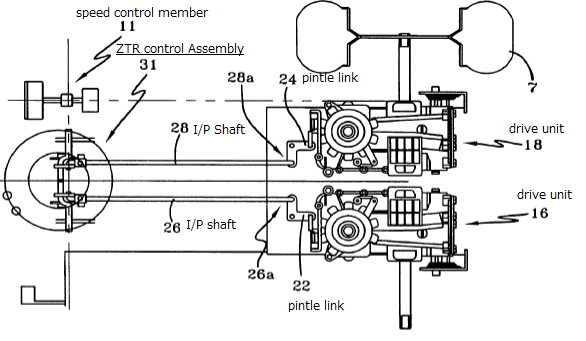
|
CAFC判決 MTD Products Inc. v. Iancu (PTAB) 2019年 8月12
日 Means
+ Function解釈に関して OPINION by JUDGE STOLL (Reyna, Taranto) Summarized
by Tatsuo YABE 2019-10-03 |
|
本事案はクレームの構成要素には112条6項解釈が適用されるべきであると権利者が主張し権利の無効化に対抗したという面白い判決である。言い換えると、通常、特許権者(出願人)は6項解釈を回避しようと努力するのに対して6項解釈を適用することでメリットもあるということを明示した判決である。
|
PTABでは問題となったUSP458特許クレームの”mechanical
control assembly”に6項解釈を適用しない(明細書と経過書類を参酌すると”mechanical
control assembly”には構造体の意味を含むと理解される)と判断したため先行技術によってクレームは自明であると判断された。しかし控訴審(CAFC)においては、PTABの6項解釈を適用しないという判断が間違いであるとし問題となった用語”mechanical
control assembly”を6項解釈すると判断した。(以上筆者)
|
■■■■■■■■■■■■■■■■■■■■■■■■■■■■■■■■■■
■ 事件の背景:
Toro(被疑侵害者)はMTD社(特許権者)のUSP458の無効を訴えIPR手続きをPTABに申請した。PTABはMTDのUSP458
のクレーム1は自明であると判断した。自明性の判断の要となったのはクレーム1の構成要素(”mechanical
control assembly”)を112条6項で解釈しないということであった(即ち、MPF解釈されないので用語の権利範囲を広く解釈され先行技術によって自明と判断された)。MTDはPTABの審決を不服としCAFCに控訴した。主たる控訴理由はPTABの112条6項解釈しないという判断は間違いという点である。
|
CAFCはPTABの判断(6項解釈を適用しない)は間違いであるとして破棄差戻しとした。
|
■ 特許権者:MTD
■ 関連特許:USP
8,011,458
■ 特許発明の概要:
Zero-Turn-Radius型の車両(特に芝刈り機)に関する。ZTRとは極小さい半径で左右の回転ができるという特徴である。尚、ZTRという技術は周知であり、本特許では普通の車両の操作をまねるべくハンドル操作方向に合致する前方回転及び後方回転を可能にした。(従来技術においてはハンドルを右回転させアクセルを踏むと前方右方向に旋回するが、アクセルを車両を逆方向に動くように踏み込むと車両は後方左方向に旋回するので運転者の直感に沿わないという問題があった)
代表図(FIG.
2)

■ 代表的なクレーム:
|
クレーム 1 |
|
|
|
A vehicle capable of making a small radius turn, comprising: |
|
■ 争点:
上記USP458クレーム1の”mechanical
control assembly”には6項解釈を適用しないというPTABの審決は正しいか?
|
■ PTABの判断:
PTABはTOROの主張「”mechanical
control assembly”は112条6項解釈される他の用語と類似している」に同意した。さらに、当該用語は全てではないにせよ、主に機能表現されており112条6項解釈が適用される傾向にあると判断した。
|
しかし458特許の明細書を参酌すると”mechanical
control assembly”という構成要素はZTR control
assemblyを意図していることが明らかであるので112条6項解釈を適用しない方に重きを置くべきであるというTOROの主張に同意した。当該クレーム用語に対応するZTR
control assemblyの構成及び他の部材との連結具合は明細書で詳細に説明されているので当業者であれば当該用語は構造であると解釈される。
|
さらに、最も説得性のある証拠(458特許の当該用語には112条6項解釈を適用しない)は経過書類にある。MTDは審査経過中に引例と識別するために当該用語の構造的な意味合いを説明し、当該構造は引例には開示されていないと主張した。このMTDの主張がまさに当該用語は構造的な限定事項(特徴)であって112条6項解釈されないと理解されるべきであると主張した。
|
上記のようにPTABは当該用語に対応する明細書の説明及び経過書類に基づき458特許クレームの当該用語に6項解釈を適用しないと判断した。
■ CAFCの判断:
クレームの構成要素に112条6項解釈を適用するか否かの判断基準は、問題となる構成要素にmeansという用語が使用されているのみではなく、問題となる用語を当業者が構造であると理解できる十分に明瞭な意味合いを持っているか否かで判断する。
The “essential inquiry is
not merely the presence or absence of the word ‘means’ but whether the words
of the claim are understood by persons of ordinary skill in the art to have a
sufficiently definite meaning as the name for structure.” Id.
|
個々の事案における重要な判断基準は、問題となるクレーム用語が構造を意味する業界用語であるのか、或いは、当業者が構造と理解するのかである。
In each case, a critical
question is whether “the claim term is used in common parlance or by
persons of skill in the pertinent art to designate structure,” including
either a particular structure or a class of structures. Skky, Inc. v. MindGeek,
s.a.r.l., 859 F.3d 1014, 1019 (Fed. Cir. 2017) (citing TecSec, Inc. v. Int’l
Bus. Machs. Corp., 731 F.3d 1336, 1347 (Fed. Cir. 2013)) (holding that the claim
term “wireless device means” does not invoke § 112, ¶ 6 because it denotes
a class of structures).
|
しかし仮に問題となる用語がnonce用語(特段の意味を持たない用語)であって機能表現されているとしても、当該用語に付随する文言が構造的な意味合いを示している場合があることに留意するべきである。依って、CAFCは問題となる用語自体を隔離し6項解釈の適否を判断するのではなく当該用語に関わる文言全てを考慮に入れて判断する。
|
6項解釈するか否かの究極の判断基準は、明細書を参酌し問題となるクレームの構成要素が十分に明瞭な構造を規定しているか否かである。
The ultimate question
is whether “the claim language, read in light of the specification, recites
sufficiently definite structure to avoid § 112, ¶ 6.” Media Rights Techs.
Inc. v. Capital One Fin. Corp., 800 F.3d 1366, 1372 (Fed. Cir. 2015) (citing
Robert Bosch, LLC v. Snap-On Inc., 769 F.3d 1094, 1099 (Fed. Cir. 2014)).
|
最後に、クレームはそれをサポートする明細書の記述を参酌し、クレーム解釈がmeansフレーズによるものか否かを判断することは正しい。例えば、出願人は辞書編集者(lexicographer)として明細書で問題となるクレーム用語に対して一般的な意味ではない意味合いであることを明瞭に規定することによって6項解釈を回避可能である。但し、辞書編集者としてクレーム用語に関する単一の実施例を記載するのみでは不十分である。寧ろ、特許権者は用語の意味合いを自身で規定するという意図を明白に示さなければならない。
Finally, we note that “[c]laims
are interpreted in light of the written description supporting them, and that is
true whether or not the claim construction involves interpreting a ‘means’
clause.” Inventio AG v. ThyssenKrupp Elevator Ams. Corp., 649 F.3d 1350, 1356
(Fed. Cir. 2011), overruled on other grounds by Williamson, 792 F.3d at 1339.
For example, a patentee may avoid application of § 112, ¶ 6 by acting as a
lexicographer and providing its own structural definition of a nonce term in the
specification by “‘clearly set[ting] forth a definition of the disputed
claim term’ other than its plain and ordinary meaning.” Thorner v. Sony
Comput. Entm’t Am. LLC, 669 F.3d 1362, 1365 (Fed. Cir. 2012) (citing CCS
Fitness, Inc. v. Brunswick Corp., 288 F.3d 1359, 1366 (Fed. Cir. 2002)).
|
上述した判例の法理に基づき判断すると、PTABが458特許の明細書で記載されたZTR
control assemblyを基礎としてクレームの”mechanical
control assembly”には特定の構造体としての意味を含有しているとした判断は間違いである。両当事者が同意するようにZTR
control assemblyがクレームの”mechanical
control assembly”に対応する構造である。
|
問題となるMPF形式の用語の意味合いを解釈するには2つのステップがある。第1のステップでは、クレームがMPFの形式で記載されているか否かである。このステップにおいて問題となる用語が十分明白な構造を含んでいるのかを判断する。第1ステップで問題となる用語がMPF形式であると判断される場合には、第2ステップにおいて問題となるMPF形式のクレーム用語で規定される機能を実現する構造を明細書で特定する。これら2つのステップは互いに関連性はあるが個々に識別されるものである。PTABはこれら2つのステップを混同したと理解される。即ち、PTABは、問題となる構成要素(MPF解釈されると主張されている構成要素)に対応する構造が明細書に開示されているので問題となる用語には6項解釈を適用しないと判断している。言い換えると、PTABはクレーム用語に対応する構造が明細書に開示されてさえすれば当該用語には6項解釈を適用しないと述べていることになる。このように判断するのであれば112条6項解釈されるクレームの用語はなくなる。
|
6項解釈をクレームの用語に適用するか否かを判断するのに明細書を参酌するということは正しい。然しながら、本事案において、特許権者が辞書編集者として、クレームの”mechanical
control assembly”の意味合いをZTR control
assemblyであると規定したという意図は458特許の明細書から理解できない。そもそも458特許の明細書には”mechanical
control assembly”という用語すら存在しない。
The specification does not
demonstrate that the patentee intended to act as its own lexicographer
and define the nonce term “mechanical control assembly” as the “ZTR
control assembly” of the preferred embodiment. Indeed, the specification does
not even refer to a “mechanical control assembly.”
|
さらに、PTABが経過書類を参酌し、458特許クレームの”mechanical
control assembly”は構造を意味していると結論づけたのは間違いである。出願審査経過におけるMTDの主張はあくまでクレームの特定の機能を実行する”mechanical
control assembly”という構成要素は特定の構造を含み、単に意図された目的ではないのでクレームの限定事項として解釈するべきであると述べたのであって6項解釈を適用するか否かに対して言及したものではない。
Rather, MTD’s statements
indicated that the phrase “mechanical control assembly configured to”
perform certain functions must be given weight because it connotes structure and
thus is not merely an intended use. These statements were not made within the
context of § 112, ¶ 6.
|
事実、MPF形式の構成要素であっても構造(corresponding
structure)の意味合いを含むのであり、審査においてウェイトが置かれる(限定事項として解釈される)。さらに、問題となるクレーム用語に6項解釈を適用するか否かのPTABの判断時期はWilliamson事件(2015年のWilliamson大法廷判決)の前であるという点も注記しておく。上記のように、問題となる用語に6項解釈の適用を否定する明白な記録が存在しないのでPTABの経過書類に基づく判断は間違いである。
|
上記理由により458特許クレームの”mechanical
control assembly”は112条6項解釈が適用される。依って、PTABの判決を破棄・差戻しとする。
|
■■■■■■■■■■■■■■■■■■■■■■■■■■■■■■■■■■
|
REFERENCES
Williamson v. Citrix
Online, LLC, 792 F.3d (Fed. Cir. en banc 2015)
http://www.tatsuoyabe.aki.gs/Williamson_v_Citrix_FedCir_enbanc_2015_06_16.htm
|
|
(5)
LINKS
|